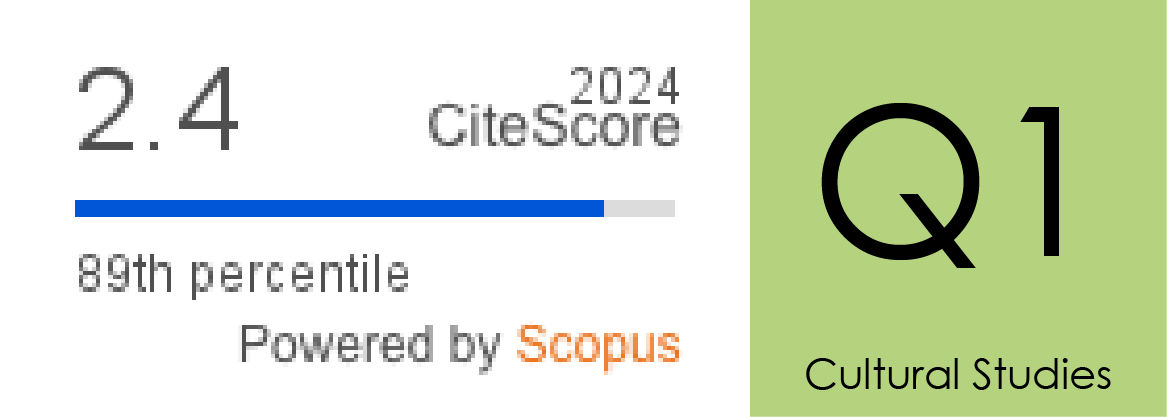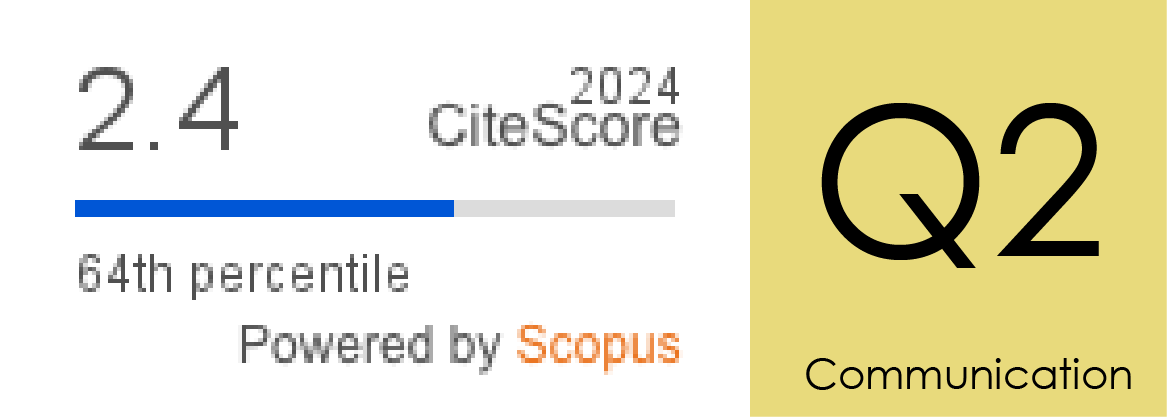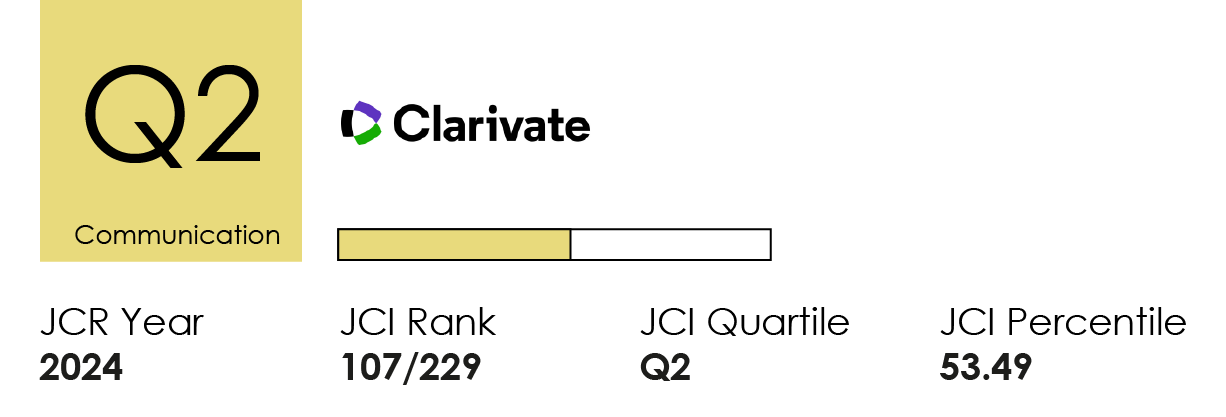Identidad y branding de barrio: retos y tendencias para la marca-lugar
DOI:
https://doi.org/10.14198/MEDCOM.28430Palabras clave:
Gentrificación, Identidad barrial, Branding barrial, Urbanismo, Marga de lugar, Estrategias de brandingResumen
Propósito. Este estudio analiza la relación entre la identidad de barrio (neighborhood identity) y el branding de barrio (neighborhood branding) con el objetivo de comprender su evolución en la literatura académica, identificar sus intersecciones y divergencias, y explorar su impacto en la planificación urbana y la percepción de los residentes. Metodología. Se llevó a cabo una revisión sistemática de la literatura basada en el análisis de 161 artículos indexados en Scopus y Web of Science. Se empleó un enfoque mixto que combina análisis bibliométrico y síntesis conceptual cualitativa, evaluando las principales contribuciones académicas, tendencias conceptuales y disciplinas involucradas en el estudio de estos conceptos. Resultados y conclusiones. Los hallazgos indican que la investigación sobre identidad barrial está más consolidada y se desarrolla en múltiples disciplinas, como las ciencias sociales, los estudios urbanos y la psicología social. En contraste, el branding de barrio es un campo emergente con un enfoque predominante en la planificación urbana y la administración pública. Ambos conceptos comparten preocupaciones sobre la gentrificación, aunque desde perspectivas diferentes: la identidad de barrio se centra en la percepción y el sentido de pertenencia de los residentes, mientras que el branding de barrio examina su impacto en la comercialización y el reposicionamiento de los espacios urbanos. Se destaca la necesidad de una mayor integración transdisciplinaria para desarrollar estrategias de branding más equitativas y sostenibles. Aportación original. Este estudio ofrece una visión integral y actualizada de la evolución de la identidad y el branding de barrio, dos conceptos interrelacionados pero que han sido estudiados de manera separada. La combinación de enfoques metodológicos permite identificar vacíos teóricos y oportunidades de investigación futura. Además, se presentan recomendaciones clave para investigadores en place branding y profesionales del marketing y la planificación urbana interesados en desarrollar estrategias de branding inclusivas y adaptadas al contexto local.
Citas
Arruda, H., Silva, E. R., Lessa, M., Proença, D., & Bartholo, R. (2022). VOSviewer and Bibliometrix. Journal of the Medical Library Asociación: JMLA, 110(3), 392-395. https://doi.org/10.5195/jmla.2022.1434
Barboza-Palomino, M. (2021). Una guía para desarrollar estudios bibliométricos en Psicología. Revista Peruana de Historia de la Psicología, 7, 37-43. https://shre.ink/Mzg8
Campbell, E., Henly, J. R., Elliott, D. S., & Irwin, K. (2009). Subjective Constructions of Neighborhood Boundaries: Lessons from a Qualitative Study of Four Neighborhoods. Journal of Urban Affairs, 31(4), 461-490. https://doi.org/10.1111/j.1467-9906.2009.00450.x
Coletti, R., & Rabbiosi, C. (2021). Neighbourhood branding and urban regeneration: Performing the ‘right to the brand’ in Casilino, Rome. Urban Research & Practice, 14(3), 264-285. https://doi.org/10.1080/17535069.2020.1730946
Collins, B. (2024). Place Branding and Its Discontents: The Politics and Management of Neighborhood Governance Systems. Journal of Planning Education and Research, 44(2), 649-661. https://doi.org/10.1177/0739456X21998448
Del-Ponti, P., Barrientos-Báez, A., & Caldevilla-Domínguez, D. (2022). City Branding: Communication and marketing strategy for an island urban policy. Revista Mediterránea de Comunicación, 13(1), 317-329. https://doi.org/10.14198/MEDCOM.19758
Dowling, G. R. (2001). Creating corporate reputations: Identity, image, and performance. Oxford University Press.
Elahi, A., McIntyre, J. C., Hampson, C., Bodycote, H. J., Sitko, K., White, R. G., & Bentall, R. P. (2018). Home is where you hang your hat: Host town identity, but not hometown identity, protects against mental health symptoms associated with financial stress. Journal of Social and Clinical Psychology, 37(3), 159-181. https://doi.org/10.1521/jscp.2018.37.3.159
Ferenhof, H. A., y Fernandes, R. F. (2016). Desmistificando a revisão de literatura como base para redação científica: Método SFF. Revista ACB, 21(3). https://bit.ly/47ZpO7b
Ferilli, G., Sacco, P. L., Tavano Blessi, G., & Forbici, S. (2017). Power to the people: When culture works as a social catalyst in urban regeneration processes (and when it does not). European Planning Studies, 25(2), 241-258. https://doi.org/10.1080/09654313.2016.1259397
Fink, A. (2019). Conducting Research Literature Reviews: From the Internet to Paper. SAGE Publications.
García-Carrizo, J. (2021). City branding. Fundamentos y aplicaciones de marca en espacios culturales y creativos. Fragua.
Ghanem, S., El-Fiki, S., Khalifa, M., & Afifi, S. (2024). District branding: Content analysis toward identifying brand dimensions at the district scale. Place Branding and Public Diplomacy. https://doi.org/10.1057/s41254-024-00343-8
Gharavi, M. (2018). From Traditional to Contemporary Neighborhood, A Study on Revitalizing Neighborhood Identity in Contemporary City. Armanshahr Architecture & Urban Development, 10(21), 61-76. https://bit.ly/3QoKHjY
Guttentag, D. (2015). Airbnb: Disruptive innovation and the rise of an informal tourism accommodation sector. Current Issues in Tourism, 18(12), 1192-1217. https://doi.org/10.1080/13683500.2013.827159
Harvey, D. (2013). Rebel cities: From the right to the city to the urban revolution (Paperback ed). Verso.
Hays, R. A., & Kogl, A. M. (2007). Neighborhood Attachment, Social Capital Building, and Political Participation: A Case Study of Low- and Moderate-Income Residents of Waterloo, Iowa. Journal of Urban Affairs, 29(2), 181-205. https://doi.org/10.1111/j.1467-9906.2007.00333.x
Hwang, J. (2016). The Social Construction of a Gentrifying Neighborhood: Reifying and Redefining Identity and Boundaries in Inequality. Urban Affairs Review, 52(1), 98-128. https://doi.org/10.1177/1078087415570643
Kapferer, J.-N. (1992). Strategic Brand Management: New Approaches to Creating and Evaluating Brand Equity. Simon and Schuster.
Karaman, O. (2014). Resisting urban renewal in Istanbul. Urban Geography, 35(2), 290-310. https://doi.org/10.1080/02723638.2013.865444
Keatinge, B., & Martin, D. G. (2016). A ‘Bedford Falls’ kind of place: Neighbourhood branding and commercial revitalisation in processes of gentrification in Toronto, Ontario. Urban Studies, 53(5), 867-883. https://doi.org/10.1177/0042098015569681
Lees, L. (2008). Gentrification and Social Mixing: Towards an Inclusive Urban Renaissance? Urban Studies, 45(12), 2449-2470. https://doi.org/10.1177/0042098008097099
Levy, D., & Lee, C. K. C. (2011). Neighbourhood identities and household location choice: Estate agents’ perspectives. Journal of Place Management and Development, 4(3), 243-263. https://doi.org/10.1108/17538331111176066
Marcuse, P. (2009). From critical urban theory to the right to the city. City, 13(2-3), 185-197. https://doi.org/10.1080/13604810902982177
Masuda, J. R., & Bookman, S. (2018). Neighbourhood branding and the right to the city. Progress in Human Geography, 42(2), 165-182. https://doi.org/10.1177/0309132516671822
Matos, F. F., Olaya, J. C., & Contreras, F. (2023). Introducción a la bibliometría práctica. Asociación de Bibliotecólogos del Perú.
Mueller, A., & Schade, M. (2012). Symbols and place identity. Journal of Place Management and Development, 5(1), 81-92. https://doi.org/10.1108/17538331211209068
Muhonen, T., Hirvonen, S., & Laukkanen, T. (2017). SME brand identity: Its components, and performance effects. Journal of Product & Brand Management, 26(1), 52-67. https://doi.org/10.1108/JPBM-01-2016-1083
Nandan, S. (2005). An exploration of the brand identity–brand image linkage: A communications perspective. Journal of Brand Management, 12(4), 264-278. https://doi.org/10.1057/palgrave.bm.2540222
Oja, B. D., Wear, H. T., & Clopton, A. W. (2018). Major Sport Events and Psychic Income: The Social Anchor Effect. Journal of sports management, 32(3), 257-271. https://doi.org/10.1123/jsm.2016-0170
Olins, W. (2002). Branding the nation—The historical context. Journal of Brand Management, 9(4), 241-248. https://doi.org/10.1057/palgrave.bm.2540075
Olins, W. (2005). Making a National Brand. In, J. Melissen (Ed.), The New Public Diplomacy: Soft Power in International Relations, (pp. 169-179). Palgrave Macmillan UK. https://doi.org/10.1057/9780230554931_9
Pasalar, C., & Hallowell, G. D. (2019). A grassroots research approach for branding urban districts. Archnet-IJAR: International Journal of Architectural Research, 13(2), 331-348. https://doi.org/10.1108/ARCH-03-2019-0047
Pemberton, S., & Phillimore, J. (2018). Migrant place-making in super-diverse neighbourhoods: Moving beyond ethno-national approaches. Urban Studies, 55(4), 733-750. https://doi.org/10.1177/0042098016656988
Pritchard, A. (1969). Statistical Bibliography or Bibliometrics? Journal of Documentation, 25, 348-349.
Rabii, W. (2023). Global Appeal: Colorblindness, Neoliberalism, and Neighborhood Branding. Critical Sociology, 49(7-8), 1211-1230. https://doi.org/10.1177/08969205221146268
Ramezi, M., Yeganeh, M., & Bemanian, M. (2022). The role of place branding in promoting social capital in urban areas (case study: Ahvaz, Iran). Frontiers in Built Environment, 8. https://doi.org/10.3389/fbuil.2022.889139
Ross, J., & Harradine, R. (2011). Fashion value brands: The relationship between identity and image. Journal of Fashion Marketing and Management: An International Journal, 15(3), 306-325. https://doi.org/10.1108/13612021111151914
Ruiz-Real, J. L., Uribe-Toril, J., & Gázquez-Abad, J. C. (2020). Destination branding: Opportunities and new challenges. Journal of Destination Marketing & Management, 17, 100453. https://doi.org/10.1016/j.jdmm.2020.100453
Sánchez, M. V. G., y Cancino, J. L. T. (2013). Los mapas bibliométricos o mapas de la ciencia: Una herramienta útil para desarrollar estudios métricos de información. Biblioteca Universitaria, 16(2), 95-108. https://doi.org/10.22201/dgb.0187750xp.2013.2.5
Smith, M. E. (2010). The archaeological study of neighborhoods and districts in ancient cities. Journal of Anthropological Archaeology, 29(2), 137-154. https://doi.org/10.1016/j.jaa.2010.01.001
Smith, R. L. (1984). Creating neighborhood identity through citizen activism. Urban Geography, 5(1), 49-70. https://doi.org/10.2747/0272-3638.5.1.49
Snyder, H. (2019). Literature review as a research methodology: An overview and guidelines. Journal of Business Research, 104, 333-339. https://doi.org/10.1016/j.jbusres.2019.07.039
Stevenson, C., Wakefield, J. R. H., Felsner, I., Drury, J., & Costa, S. (2021). Collectively coping with coronavirus: Local community identification predicts giving support and lockdown adherence during the COVID-19 pandemic. British Journal of Social Psychology, 60(4), 1403-1418. https://doi.org/10.1111/bjso.12457
Taecharungroj, V. (2018). City-district divergence grid: a multi-level city brand positioning tool. Place Branding and Public Diplomacy, 14(2), 101-114. https://doi.org/10.1057/s41254-017-0077-3
Talen, E., Menozzi, S., & Schaefer, C. (2015). What is a “Great Neighborhood”? An Analysis of APA’s Top-Rated Places. Journal of the American Planning Association, 81(2), 121-141. https://doi.org/10.1080/01944363.2015.1067573
Van Eck, N. J., & Waltman, L. (2017). Citation-based clustering of publications using CitNetExplorer and VOSviewer. Scientometrics, 111(2), 1053-1070. https://doi.org/10.1007/s11192-017-2300-7
Van Raan, A. F. (2014). Advances in bibliometric analysis: research performance assessment and science mapping. Bibliometrics Use and Abuse in the Review of Research Performance, 87(4), 17-28. https://shre.ink/MzbG
Wherry, F. F. (2012). Performance Circuits in the Marketplace. Politics & Society, 40(2), 203-221. https://doi.org/10.1177/0032329212441598
Willer, C. J. (2022). Rebranding place “to build community”: Neighborhood branding in Buffalo, NY. Urban Geography, 43(9), 1350-1371. https://doi.org/10.1080/02723638.2021.1927323
Ye, M., & Chen, Y. (2014). The influence of domestic living arrangement and neighborhood identity on mental health among urban Chinese elders. Aging & Mental Health, 18(1), 40-50. https://doi.org/10.1080/13607863.2013.837142
Zavattaro, S. M. (2021). Why Is This So Hard?: An Autoethnography of Qualitative Interviewing. Public Performance & Management Review, 44(5), 1052-1074. https://doi.org/10.1080/15309576.2020.1734035
Descargas
Estadísticas
Publicado
Cómo citar
Número
Sección
Licencia
Derechos de autor 2018 Iñigo Urquia-Uriaguereca

Esta obra está bajo una licencia internacional Creative Commons Atribución 4.0.
Los autores y autoras que publican en esta revista están de acuerdo con los siguientes términos:
1 Derechos de autor. Los autores y autoras conservan sus derechos de autor, aunque ceden a la revista de forma no exclusiva los derechos de explotación (reproducción, distribución, comunicación pública y transformación) y garantizan a esta el derecho de primera publicación de su trabajo, el cual estará simultáneamente sujeto a la licencia indicada en punto 2. Los autores pueden establecer otros acuerdos adicionales para la distribución no exclusiva de la versión de la obra publicada en la revista, siempre que exista un reconocimiento de su publicación inicial en esta revista.
© Los autores.
2 Licencia. Los trabajos se publican en la revista sujetos a la licencia de Reconocimiento 4.0 Internacional de Creative Commons (CC BY 4.0); los términos se pueden consultar en https://creativecommons.org/licenses/by/4.0/
Esta licencia permite a terceros compartir (copiar y redistribuir el material en cualquier medio o formato) y adaptar (remezclar, transformar y crear a partir del material para cualquier finalidad, incluso comercial), siempre que se reconozca la autoría y la primera publicación en esta revista (Revista Mediterránea de Comunicación (RMC) / Mediterranean Journal of Communication (MJC), Universidad de Alicante, DOI de la obra), se proporcione un enlace a la licencia y se indique si se han realizado cambios en la obra.
3 Política de autoarchivo. Se recomienda a los autores que difundan sus trabajos a través de Internet para favorecer una circulación y difusión más rápidas y, con ello, un posible aumento en la citación y alcance entre la comunidad científica y académica, en las siguientes condiciones:
No se permite a los autores depositar en un repositorio institucional o temático, página web propia, etc., las versiones preprint (versión antes de ser evaluada) o postprint (versión evaluada y aceptada para su publicación) de sus trabajos antes de su publicación, pero sí el artículo final publicado (versión del editor).













